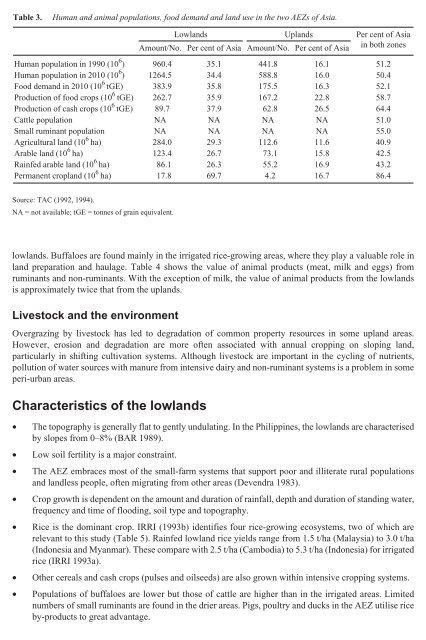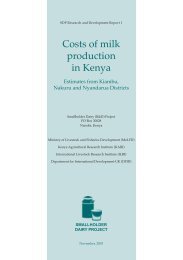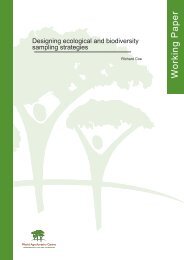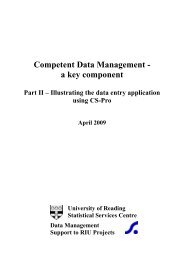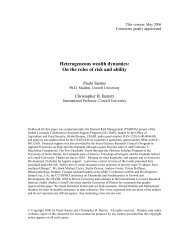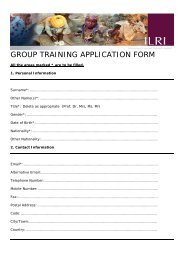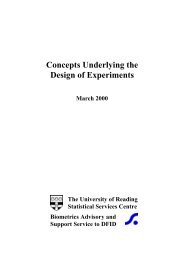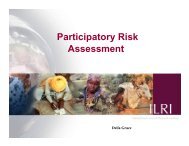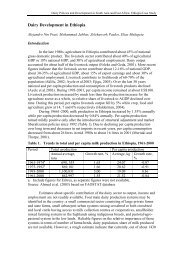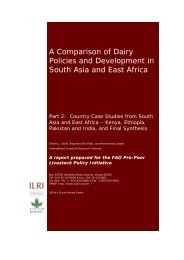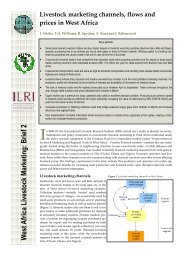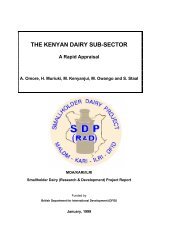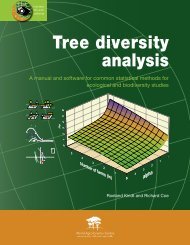Table 2.Importance <strong>of</strong> ra<strong>in</strong>fed agriculture <strong>in</strong> South-East Asia.CountryTotal ra<strong>in</strong>fedarea (10 6 ha)Arable land as aproportion <strong>of</strong> totalra<strong>in</strong>fed area (%)Ra<strong>in</strong>fed productionas proportion <strong>of</strong>agricultural GDP (%)Populationdependent on ra<strong>in</strong>fedagriculture (%)Average farmsize (ha)ASEANIndonesia 9.1 62.7 19.1 36.8 0.8Malaysia 0.7 67.5 16.0 40.2 1.4Philipp<strong>in</strong>es 6.5 82.3 22.3 36.0 1.9Thailand 13.8 81.6 49.9 59.4 4.3MekongCambodia 2.8 96.9 NA NA 2.5Lao PDR 0.8 94.6 NA 85.0 1.3Myanmar 8.9 89.8 61.1 46.0 2.3Vietnam 4.4 71.6 NA 75.0 2.0Ch<strong>in</strong>a † 52.0 53.8 33.0 30.0 0.5–1.0Sources: ADB (1996) and data from the <strong>in</strong>dividual countries.NA: not available.† Data refer to the whole country, as separate data are not available for South Ch<strong>in</strong>a.SoilsAccord<strong>in</strong>g to Dent (1980), 86% <strong>of</strong> soils <strong>in</strong> South-East Asia have serious limitations <strong>of</strong> m<strong>in</strong>eral stress (59%),water excess (19%), shallow depth (6%) and drought (2%). Most soils are ultisols and oxisols. Descriptions<strong>of</strong> these soils are given by Dent (1980) and Dudal (1980). These soils occupy 50% <strong>of</strong> the land area <strong>of</strong> tropicalAsia, and cover 188 million ha <strong>of</strong> uplands <strong>in</strong> South-East Asia (Garrity and Agust<strong>in</strong> 1995). Ultisols are moreimportant than oxisols <strong>in</strong> the region; the latter be<strong>in</strong>g more widespread <strong>in</strong> South America and sub-SaharanAfrica. For example, <strong>in</strong> Indonesia, there are 49 million ha (25.7% <strong>of</strong> the total land area) <strong>of</strong> ultisols and 18million ha <strong>of</strong> oxisols, with major areas occurr<strong>in</strong>g on the islands <strong>of</strong> Sumatera and Kalimantan. In thePhilipp<strong>in</strong>es, ultisols and oxisols cover 17 million ha (58% <strong>of</strong> the land area) whilst <strong>in</strong> Thailand, ultisols occupy44.8% <strong>of</strong> the land area and oxisols less than one per cent. In Malaysia and Myanmar, 52.8 and 59.5% <strong>of</strong>arable land, respectively, are ultisols and oxisols. These soils present severe physical constra<strong>in</strong>ts forpermanent cultivation, with low <strong>in</strong>herent fertility (especially phosphorus), high acidity (pH 3.5–5.0), toxiclevels <strong>of</strong> alum<strong>in</strong>ium, low organic matter content, high erodability and poor water economy.Ra<strong>in</strong>fed farm<strong>in</strong>g systems <strong>in</strong> the agro-ecological zonesGeneralBackground <strong>in</strong>formation for Asia on the target AEZs is shown <strong>in</strong> Table 3. Currently, data for the AEZs <strong>in</strong>South-East Asia are not available, so the statistics presented <strong>in</strong>clude south Asia. However, most <strong>of</strong> the humidand sub-humid lowlands are found <strong>in</strong> South-East Asia as the lowlands <strong>of</strong> south Asia are semi-arid or arid. Thelowlands have larger areas <strong>of</strong> arable and permanent cropland, which account for the greater crop production <strong>in</strong>this AEZ. The data also <strong>in</strong>dicate that about 51% <strong>of</strong> the cattle and 55% <strong>of</strong> the small rum<strong>in</strong>ant populations <strong>in</strong> Asiaare found <strong>in</strong> these AEZs. Unfortunately, no data were available for the sizes <strong>of</strong> buffalo and non-rum<strong>in</strong>ant (pigsand poultry) populations, but relatively large numbers <strong>of</strong> more than 75% <strong>of</strong> buffaloes and about 70% <strong>of</strong>non-rum<strong>in</strong>ants are found on small farms. The buffaloes are ma<strong>in</strong>ly the swamp type <strong>in</strong> South-East Asia, and areassociated with about 33% <strong>of</strong> the total population <strong>of</strong> buffaloes <strong>in</strong> Asia (Chantalakhana 1994).Mixed farm<strong>in</strong>g systems that <strong>in</strong>clude crops and animals are found <strong>in</strong> the AEZs. Annual crops (rice, wheat,maize, pulses and oilseeds) and perennial tree crops (coconut, oil palm, rubber and fruits) are grown, andboth rum<strong>in</strong>ants (buffaloes, cattle, goats and sheep) and non-rum<strong>in</strong>ants (pigs and poultry) are <strong>in</strong>tegrated <strong>in</strong>tothese systems. Pig and poultry breeds are ma<strong>in</strong>ly <strong>of</strong> the <strong>in</strong>digenous types. Ducks predom<strong>in</strong>ate <strong>in</strong> the ra<strong>in</strong>fed
Table 3.Human and animal populations, food demand and land use <strong>in</strong> the two AEZs <strong>of</strong> Asia.Lowlands Uplands Per cent <strong>of</strong> Asia<strong>in</strong> both zonesAmount/No. Per cent <strong>of</strong> Asia Amount/No. Per cent <strong>of</strong> AsiaHuman population <strong>in</strong> 1990 (10 6 ) 960.4 35.1 441.8 16.1 51.2Human population <strong>in</strong> 2010 (10 6 ) 1264.5 34.4 588.8 16.0 50.4Food demand <strong>in</strong> 2010 (10 6 tGE) 383.9 35.8 175.5 16.3 52.1<strong>Production</strong> <strong>of</strong> food crops (10 6 tGE) 262.7 35.9 167.2 22.8 58.7<strong>Production</strong> <strong>of</strong> cash crops (10 6 tGE) 89.7 37.9 62.8 26.5 64.4Cattle population NA NA NA NA 51.0Small rum<strong>in</strong>ant population NA NA NA NA 55.0Agricultural land (10 6 ha) 284.0 29.3 112.6 11.6 40.9Arable land (10 6 ha) 123.4 26.7 73.1 15.8 42.5Ra<strong>in</strong>fed arable land (10 6 ha) 86.1 26.3 55.2 16.9 43.2Permanent cropland (10 6 ha) 17.8 69.7 4.2 16.7 86.4Source: TAC (1992, 1994).NA = not available; tGE = tonnes <strong>of</strong> gra<strong>in</strong> equivalent.lowlands. Buffaloes are found ma<strong>in</strong>ly <strong>in</strong> the irrigated rice-grow<strong>in</strong>g areas, where they play a valuable role <strong>in</strong>land preparation and haulage. Table 4 shows the value <strong>of</strong> animal products (meat, milk and eggs) fromrum<strong>in</strong>ants and non-rum<strong>in</strong>ants. With the exception <strong>of</strong> milk, the value <strong>of</strong> animal products from the lowlandsis approximately twice that from the uplands.<strong>Livestock</strong> and the environmentOvergraz<strong>in</strong>g by livestock has led to degradation <strong>of</strong> common property resources <strong>in</strong> some upland areas.However, erosion and degradation are more <strong>of</strong>ten associated with annual cropp<strong>in</strong>g on slop<strong>in</strong>g land,particularly <strong>in</strong> shift<strong>in</strong>g cultivation systems. Although livestock are important <strong>in</strong> the cycl<strong>in</strong>g <strong>of</strong> nutrients,pollution <strong>of</strong> water sources with manure from <strong>in</strong>tensive dairy and non-rum<strong>in</strong>ant systems is a problem <strong>in</strong> someperi-urban areas.Characteristics <strong>of</strong> the lowlands• The topography is generally flat to gently undulat<strong>in</strong>g. In the Philipp<strong>in</strong>es, the lowlands are characterisedby slopes from 0–8% (BAR 1989).• Low soil fertility is a major constra<strong>in</strong>t.• The AEZ embraces most <strong>of</strong> the small-farm systems that support poor and illiterate rural populationsand landless people, <strong>of</strong>ten migrat<strong>in</strong>g from other areas (Devendra 1983).• <strong>Crop</strong> growth is dependent on the amount and duration <strong>of</strong> ra<strong>in</strong>fall, depth and duration <strong>of</strong> stand<strong>in</strong>g water,frequency and time <strong>of</strong> flood<strong>in</strong>g, soil type and topography.• Rice is the dom<strong>in</strong>ant crop. IRRI (1993b) identifies four rice-grow<strong>in</strong>g ecosystems, two <strong>of</strong> which arerelevant to this study (Table 5). Ra<strong>in</strong>fed lowland rice yields range from 1.5 t/ha (Malaysia) to 3.0 t/ha(Indonesia and Myanmar). These compare with 2.5 t/ha (Cambodia) to 5.3 t/ha (Indonesia) for irrigatedrice (IRRI 1993a).• Other cereals and cash crops (pulses and oilseeds) are also grown with<strong>in</strong> <strong>in</strong>tensive cropp<strong>in</strong>g systems.• Populations <strong>of</strong> buffaloes are lower but those <strong>of</strong> cattle are higher than <strong>in</strong> the irrigated areas. Limitednumbers <strong>of</strong> small rum<strong>in</strong>ants are found <strong>in</strong> the drier areas. Pigs, poultry and ducks <strong>in</strong> the AEZ utilise riceby-products to great advantage.
- Page 2 and 3: Affiliation of Authors:Dr C. Devend
- Page 4 and 5: 6.Strategyfor researchJustification
- Page 7 and 8: AcknowledgementsThe International L
- Page 9 and 10: esearch opportunities appropriate t
- Page 11 and 12: Table 1.Animal populations and meat
- Page 13 and 14: Introduction2. Characterisation and
- Page 15: Figure 2. Sub-humid tropics and sub
- Page 19 and 20: Table 5. Rice-growing environments
- Page 21 and 22: Multiple upland annual crop systems
- Page 23 and 24: Table 6. Continued.Country Importan
- Page 25 and 26: It should be noted that, compared w
- Page 27 and 28: Table 8.CountryCambodiaChinaIndones
- Page 29 and 30: of non-renewable fossil fuels and t
- Page 31 and 32: Overview of researchThere was a sur
- Page 33 and 34: • Identification of alternative c
- Page 35 and 36: Various animal production systems t
- Page 37 and 38: Presently, much of the vegetable pr
- Page 39 and 40: Table 10. Summary of the main socio
- Page 41 and 42: Table 11. Institutions and organisa
- Page 43 and 44: 3. In the ASEAN sub-region, inadequ
- Page 45 and 46: Table 12. Continued.SituationsPract
- Page 47 and 48: 6. Strategy for researchJustificati
- Page 49 and 50: Table 13. Priorities for research a
- Page 51 and 52: VietnamResearch capacity in NARS is
- Page 53 and 54: CRIFC (Central Research Institute f
- Page 55 and 56: IAS. 1995. Proceedings of the Works
- Page 57 and 58: Systems of sub-Saharan Africa. Volu
- Page 59 and 60: or waterlogged in the wet season an
- Page 61 and 62: Table A1. Important diseases of ani
- Page 63 and 64: • Increased cropping intensities,
- Page 65 and 66: the animal output came from pigs al
- Page 67 and 68:
18-21° North, with an average rain
- Page 69 and 70:
In the Nusa Tenggara islands, signi
- Page 71 and 72:
Women work 11.5 h/day on average co
- Page 73 and 74:
Various Australian forage projects
- Page 75 and 76:
village production systems; to stud
- Page 77 and 78:
The availability of feed in rubber
- Page 79 and 80:
of the Ayeyarwady and Sittang river
- Page 81 and 82:
Constraints and opportunitiesInadeq
- Page 83 and 84:
gaining in importance, and signific
- Page 85 and 86:
Table A3. Characterisation of crop-
- Page 87 and 88:
Table A4. Interventions in crop-ani
- Page 89 and 90:
Table A4. Continued.Project TitleGo
- Page 91 and 92:
otations are practised, and there a
- Page 93 and 94:
such as abortion. Vaccination cover
- Page 95 and 96:
large areas of forests (3.4 million
- Page 97 and 98:
Table A6. Some animal diseases repo
- Page 99 and 100:
Appendix IIItineraryThe Philippines
- Page 101 and 102:
26 November 1996 am Visit to small
- Page 103 and 104:
Appendix IIIList of persons metPhil
- Page 105 and 106:
Mr Chhiv Nan, Acting Director, Depa
- Page 107 and 108:
Dr U Maung Ngint, Managing Director
- Page 109:
List of acronymsAARDACIARADBAEZAIBP


